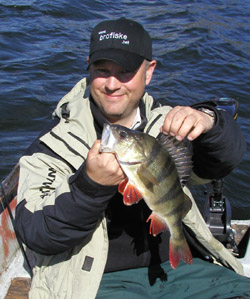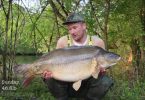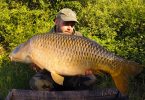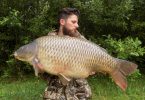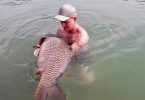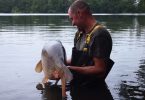by Jan Ohlsson
Abba, Volvo and big Perch! That’s Sweden in a nutshell…
Well maybe a small understatement, but for me and some of my companions the bit about the perch is true.
What a lovely fish the perch is, available for our keen interest all year: winter, summer, spring and autumn. As a bonus, in our club water they feed, like other predators, on crayfish. These are not only a prey that appears in abundance and makes the perch grow to large size in just a few years, but also one that also lends its colours to the fins of the perch, making them glowing red. If you put one of these fully-grown specimens on a bed of crystal white snow the colours seem almost supernatural, and the possibility of a God existing suddenly seems possible. Who else could create such wonderful colours?

Perch in oktober from the crayfishlake, look at those fins.
Winter Fishing
As I said we fish for perch all year. Beginning in winter, ice-fishing starts approximately in late December. The fishing often proves best just as the ice has laid its hand over the lake. The shell is thin and a floatation suit is one of our most important tools in the hunt for big perch. Bathing in December is only for eskimås and Norwegians!
This time of year the fishing often proves to be excellent. If the ice has come very suddenly, because of a fast temperature drop, the water is still “warm” and the perch have not gone into “wintercoma” yet.
We use small “icelures” made of tin and lead. To this lure we attach a small treble hook, size 10-12, that has a combination of small pieces of wool dots and coloured epoxy glue. A classic combination of colours on the hook is white and red. This is really an area of vast experimentation, with the local experts all having their own favourite combinations, and the secrecy surrounding them is the same as for expert fly-fishermen and their flies. Another kind of icelure is the “balancepirk” a small fish-like bait that imitates a small fleeing fish – very efficient on big perch, especially when the perch is hunting.

Icefishing in January, 3 lbs
Spring Fishing

Spring perch, 2.6lbs
Wonderful! After a long Swedish winter we’re back on the spinning game again. The perch are big and preparing to spawn and the females are beginning to host little “perchkorns” in their bellies. This is the time for deep fishing due to cold water. Jigs prove especially efficient. The secret of success is to let the jig fish very, and I mean very, slowly. Let it sink to the bottom and have your eyes on the line all the time. Sometimes the fish take the bait on its way down and you must be ready to strike! When the jig hits the bottom, wind it slowly towards you and make small pauses every third second. Of course this method will quite often result in a lost lure but it’s worth it.
Over the years we’ve replaced our old metallic leaders with fluorocarbon ones. This is very efficient when the fish are in a bad mood. This leader can handle pike as well but I don’t recommend it for pike fishing. After landing a pike check it out carefully and always replace or shorten the leader. The jig is also very attractive to zander. Zander spawn in May and a part of me wants to leave them alone whilst they’re making new little zanders, but sometimes accidents happen while fishing for perch, and I can’t say that I’m too unhappy on these occasions. Zander are my second fish, close to perch. Back to perch, good places to fish are those that have deep water close to the bank.
Summer Fishing

Jan O perch fishing in Summertime 3.4 lbs
There is something about the Swedish summer that gives us northerners the energy to last the winter. The sun warms the water and nature comes to life, colours are exploding, flowers and trees are blooming. It’s wonderful to be a perch fisherman!
This time of year the perch is an alert hunter, always ready to eat if it’s tempted by the right dish.
So to be an efficient perch fisher you must think like a fish (hmmm heard that before, but it’s true). Be ready to adjust your methods of fishing to suit the circumstances.
In our lake there are thousands and thousands of crayfish, and when they outgrow their shell they change it to a brand new one, just like a snake changes its skin. During the time the new shell is hardening they are very vulnerable and the perch know this for certain . Though this is the time for fishing only a few feet deep with surface lures you might be forced to choose an opposite technique. The crayfish can change shells as much as seven times in one summer. If the perch are nowhere to be seen for days, not bothering to hunt for small fish, no nothing, you can be sure that they’re eating crayfish. Change your surface lure to the good old jig, single tail yellow with a white head is my favourite. Get it down on the bottom and wind it in. As usual you must have absolute visual control of the line, the take is often only noticeable as a “soft stretch”, especially when you’re fishing deep.
By the way, we always use superlines such as Powerpro, Fireline or similar. Anything but these lines are unthinkable today. With them you feel every take, every little stretch, much better than with the old monofil lines. In the summer you can increase the spinning speed, although always let the jig bounce the bottom several times. Places to fish are those that hold lots of stones. Crayfish are always in need of good shelter like this environment.
Well, the perch isn’t always eating these little lobsters, they feed on fish too. A few years ago an old friend of mine, Andreas Dybedahl, started to adopt the American style of fishing with surface lures. This style of fishing is growing big in Sweden right now. There are lots of articles in our fishing magazines and on internet sites, partly because of our local fishing clubs’ constant preaching of its qualities as maybe the most fun method there is for perch fishing. I
t reminds me of dry fly-fishing, but the take is much more exiting and wild!
There are a lot of different surface lures to buy today. Poppers that make a lot of noise and squirting water, floating wobblers without a spoon that the fisherman controls by different techniques of moving/jerking the rod. For a year or so, our favourite has been the Super Spook by Heddon. “A big lure”, almost everyone comments on seeing it for the first time. Yes, it is big, but it catches big fish!
To be able to let the spook go “slalom” we use a rod no longer than 6-7 feet. There are many nice rods available for this kind of fishing. Actually my friend Andreas has designed one of the most sold in Sweden called “Sjöbjörnen LTJ by Push-Up”, that’s hand-made in the USA. This rod is complete with a small casting reel, size 1000-4000. The technique is simple, just make short moves with the rod up and down in a nice gentle rhythm, you´ll get the hang of it in an afternoon. The Americans calls it “walking the dog”. Always let the spook rest for a few seconds every ten feet. The perch often makes its mistake when the lure suddenly stops, and hits it aggressively in a splash of water – not for those with a heart condition! Places to fish are those that have weed or other vegetation nearby, good hiding places for little fish that hide from hunting perch and pike.
Sometimes the perch just won’t show any interest in eating your plastic. I think you know what I mean. The fish shows no interest whatsoever, it doesn’t matter what you do. This might be the best time for a surface lure! Many times when this has occurred we’ve resisted the feeling of despair and increased our effort, and been well-rewarded. We believe that it ‘s possible to “annoy” the perch to the point of rage. This results in big fish when you least expect it. If you have a hotspot, stay there and make lots of casts, vary the speed and change the colour of the spook often.


Efficient surfacelure, the perch can’t resist taking a closer look…
By the way, something about colours. A standard rule that I apply to almost all my fishing, big Baltic pike, sea trout or perch, is that I always use a bright coloured lure in fine weather and a darkish one when the sun disappears. Over the years this has worked fine and I’ve now stopped experimenting, which has led to more time for the lure to be in the water, where the fish are.
The big specimen perch are very good at keeping track of each other. If you catch one, there are almost certainly more to come. To be honest, the most spectacular takes are those made by pike. They throw themselves up in the air aiming for the lure, sometimes making a loop attempting to "kill" the spook. Absolutely awesome!
Autumn
Wonderful, nice cool air, the leaves are turning red and yellow, I love this time of year. The temperature is dropping and the fishing with surface lures slowly comes to the end for this season, sad but true. But there is still hope. Though my favourite technique for fishing this time of year is the jig I always bring my spook rod. Mind you, I’ve seen perch hunting for fish in late December, speeding near the surface like small submarines. The jig technique reminds me a lot of fishing in the spring. Slow pulls close to the bottom. Always keeping an eye on the line. When the water is going cold the perch start to slow down, using less energy. The number of their hunting trips near the surface become less and less.


The season is ending, but no one told the perch, yellow jig is deadly…
At the end of autumn, close to winter, you often find the fish deep in the lake were the water is a little bit warmer. The fish are then big and fat, having eaten all summer to manage the cold winter. Fish deep, always be on the look out for small pulls in the line, strike and enjoy a catch of wonderful fish.
And then its winter time again… drilling those holes in the ice…
Tight lines,
Jan O – 2005

